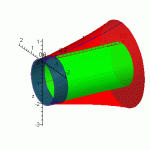The question reads:
integral_from_0_to_pi/4(pi * (tanx + 1 - 1)^2)dx
= pi * integral_from_0_to_pi/4((tanx)^2)dx
= pi * integral_from_0_to_pi/4((secx)^2 - 1)dx
= pi * [tanx - x] from 0 to pi/4
= pi * (1 - pi/4)
= Some decimal number beginning with 0.6 ....
The back of the book gives an answer that evaluates to about 2.8. What did I do wrong?
So, here's what I did. I moved up the entire thing so that it is rotated about the x-axis. That means the upper function is y = tanx + 1, and the lower function is y = 1, all this being rotated about x-axis. To find volume, I did:Find the volume of the solid given by the area bound by y = tanx, y = 0, and x = pi/4 being rotated along the y = -1 axis.
integral_from_0_to_pi/4(pi * (tanx + 1 - 1)^2)dx
= pi * integral_from_0_to_pi/4((tanx)^2)dx
= pi * integral_from_0_to_pi/4((secx)^2 - 1)dx
= pi * [tanx - x] from 0 to pi/4
= pi * (1 - pi/4)
= Some decimal number beginning with 0.6 ....
The back of the book gives an answer that evaluates to about 2.8. What did I do wrong?

